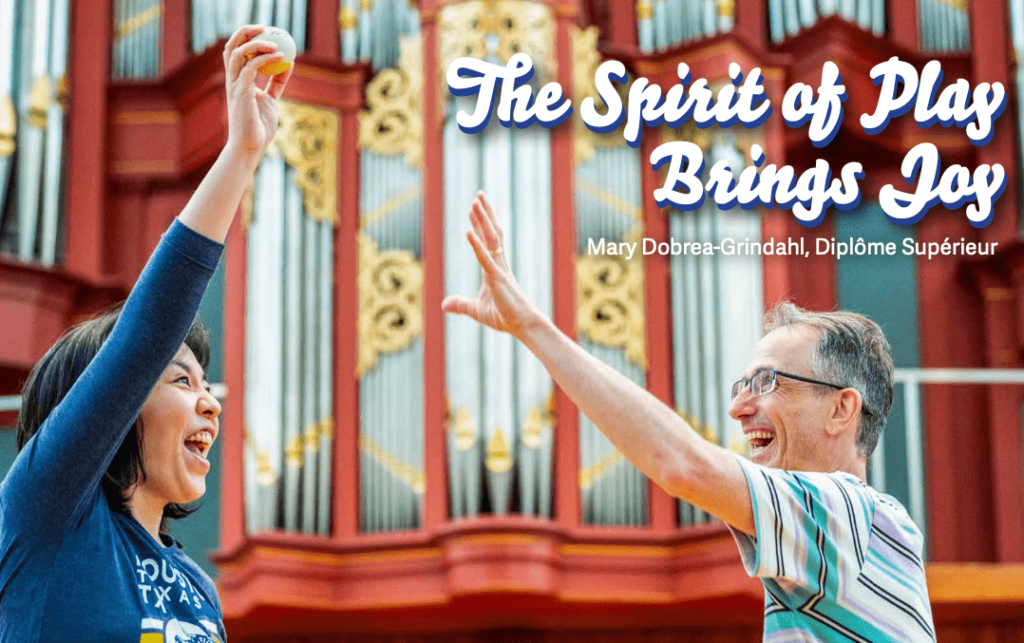
The Spirit of Play Brings Joy
One summer afternoon, I sat on my porch watching some neighborhood children playing. Their mission was to find roly-polies under a rock, and they had to find a way to move the rock to do so. One pretended he was Superman and tried to lift it. Another tried to push it. The third kicked. Each attempt resulted in laughter as they played, but they still had no roly-polies. They decided to team up, and things got serious as they tried three or four different ways to lift the rock. They were experimenting, playing, having fun, and learning, and were completely immersed in the experience; it was beautiful to watch. Finally, they decided to use a stick to lift the rock, and after a few tries, were successful—the roly-polies were exposed! This delightful scene was a real-life example of one of the principles of the Dalcroze practice: spirit of play, a fundamental tenet of the philosophy created by Émile Jaques-Dalcroze.
The spirit of play exists in every eurhythmics lesson; it’s impossible to imagine what a class would look and feel like without it. It is a gateway for many other principles of our work, and truly is as simple as it sounds. The teacher and students engage in guided, playful activities (or games) that encourage curiosity, imagination, and improvisation, leading to experiential, discovery-based learning. The spirit of play emanates first from the teacher, who brings openness, energy, and creativity to the classroom. Students, in turn, capture the sense of play and develop trust in their learning environment, resulting in a deep and lasting educational experience. We—teachers and students alike—become completely immersed in the experience, and the spirit of play becomes joy—or, more precisely, Joy.
The spirit of play exists in every eurhythmics lesson; it’s impossible to imagine what a class would look and feel like without it.
Types of Play
Today, psychologists and learning theorists recognize the benefit of play for children and adults alike. An abstract published by Psychology Today identified the types of play in which children engage, all of which help our brains make new neural connections: fantasy play, locomotor play, constructive play, language play, and games. Play that specifically involves our imagination has shown to increase cognitive flexibility, improve emotional regulation, and increase responsiveness in social situations. Play provides us a means with which to explore the world—in the case of the Dalcroze practice, to explore the world of music and ourselves. Psychologist Kathy Hirsch-Pasek has done significant research into the benefit of play and explains it beautifully:
You can teach content in a playful way. That’s what we mean by guided play. You can have a learning goal, but you can set up an environment so that the children do that by exploration and discovery. They’re the agents of their own learning…we learn better when we’re engaged in what we’re doing, not when we’re distracted. We learn best when something is meaningful, not when it has no meaning at all to us. When it’s socially interactive…when it’s iterative, that we learn a little bit more each time, kind [of] like in jazz when we learn things in different ways…And finally, here’s the shocker[:] We learn things better when it’s joyful and not when it’s boring. […] That is what we mean by active playful learning. It has a learning goal, but the pedagogy requires that teachers have more fun teaching again, and therefore the kids will have more fun learning again.
Speaking of Psychology, transcript, December 2023
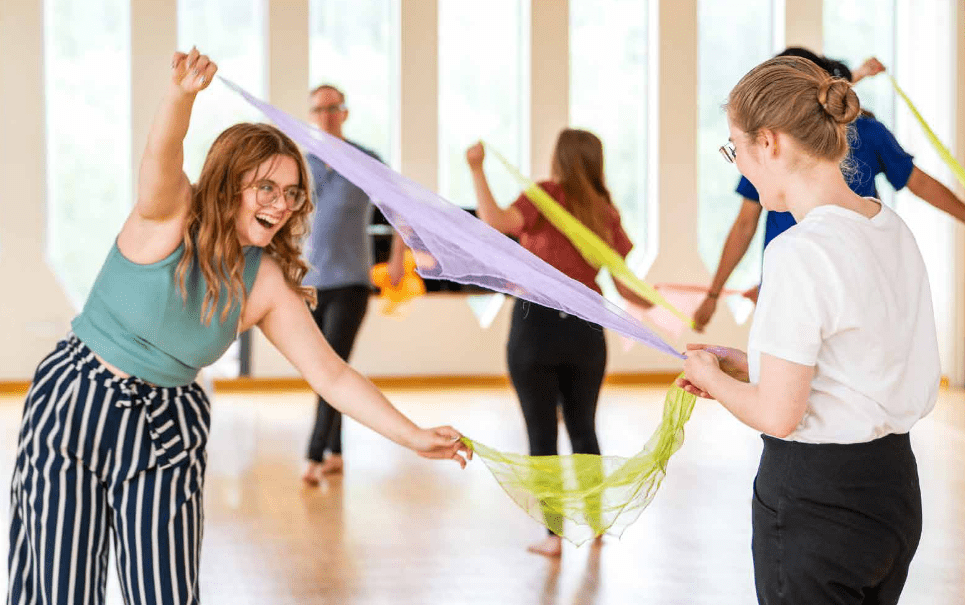
Play in a Eurhythmics Class
Let’s look at all the above in the context of a typical eurhythmics class. While I am using eurhythmics as a point of reference, much of what we will consider could happen just as easily in a solfège, improvisation, or pedagogy class.
We use “guided play” throughout a lesson. Teachers have a learning goal, whether it is teaching a folk song, piece of music, triads, or rhythm reading, and students learn through a series of graduated exercises that involve “active, playful learning.” Students remain engaged without feeling overwhelmed because the teacher skillfully layers activities. Teaching in a eurhythmics class is iterative—that is, we use repetition to ensure students understand and fully experience a subject. One advantage of our work is that we have the Dalcroze strategies at our fingertips to create the repetition (iteration) in ways that are playful and engaging, rather than using rote or pedantic teaching techniques. Hirsch-Pasek also stresses the importance of play that is socially interactive, an essential ingredient for every eurhythmics class. Finally, Hirsch-Pasek suggests that play helps students become agents of their own learning. I believe this is one of the greatest extramusical gifts eurhythmics offers—it provides an opportunity for students to develop an internal locus of control (the idea that what we do and what happens to us is determined by our own actions, rather than the result of what someone else “did”). This in turn teaches them to accept and learn from their mistakes and understand that they have the ability to make choices, which helps them develop confidence in navigating the world.
Each of the types of play psychologists have defined are on display in a well-constructed eurhythmics class. The use of locomotor play is obvious, though it is worth noting that the Dalcroze strategies (such as reaction exercises, systemization, canons) allow teachers to use locomotor play to create deeper experiences for children and adults students alike. Students engage in fantasy (or “pretend”) play frequently—it’s difficult to imagine a class where children are not asked to “be” an animal or creature of their own creation. Constructive play (which generally involves the manipulation of objects) might occur when students use balls to execute an exercise, manipulate flashcards to show a rhythm, or move hoops to show half and whole steps in a scale. We use language play in numerous ways in a class—inventing words to a melody, creating a story together, or using words to represent a rhythm. Play even extends to the first stages of plastique animée, when participants explore, improvise, and invent movement as they develop a choreography. Playful learning results in meaningful experiences and lasting memories for our students.
Guided Play with Adult Students
The value of guided play for children is well documented, but adults may benefit even more deeply by the spirit of play in the Dalcroze classroom. Play gives adults permission to rediscover their inner child and to experience music through their instinct rather than their intellect. Studies show that for adults, play reduces stress, helps with their cognitive flexibility, and improves problem-solving. The more adults allow the idea of play to permeate their experiences in all branches of our work, the greater their success is likely to be—at the very least, their experience will be a more nurturing and positive one.
I believe it is essential for teachers to encourage adult students to “jump into the tub” of the spirit of play—especially for those students who choose to pursue teacher training. Teacher training is demanding and challenging, and it’s easy to think that we aren’t “allowed” to have fun—that we’re only supposed to teach having fun, not actually do it! It is paramount to remind future teachers that the spirit of play is not just what we teach, but what we do and who we are as Dalcrozians. Meeting the challenges of our training allows us to experience play on a more profound level. When we arrive at that level, play becomes Joy.
The spirit of play is not just what we teach, but what we do and who we are as Dalcrozians.
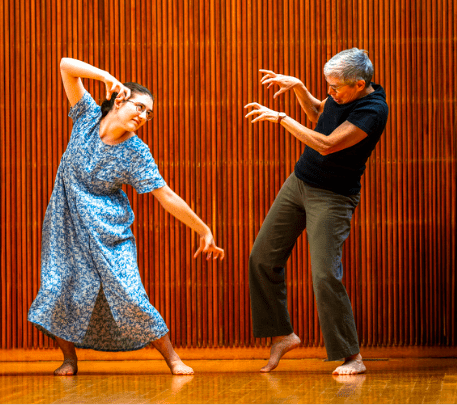
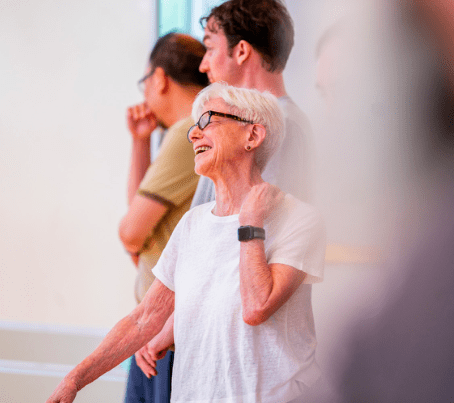
Joy, Play, and Learning
Jaques-Dalcroze recognized as early as the first decade of the twentieth century the impact play has on learning. He understood that his work affords students the means to experience something deeply personal. He wrote in Rhythm, Music & Education,
Functioning develops the organ, and the consciousness of organic functioning develops thought. And as the child feels himself delivered of all physical embarrassment, and mental obsession of an inferior order, joy will come to birth in him. This joy is a new factor in ethical progress, a new stimulus to will-power.
Rhythm, Music & Education, p. 62
How do joy and play differ? Much like happiness, play is an experience in the moment—the freedom of skipping or pleasure of working in partners to show the shape of a phrase. Joy is deeper and more enduring. It comes from within, supported and enhanced by a sense of purpose, meaning, and connection to others. In her book Essays on Rhythm, Music, Movement, Henrietta Rosenstrauch quotes Jaques-Dalcroze, who said,
I like joy, for it is life. I preach joy, for it alone gives the power of creating lasting and useful work…The joy of the daily struggle and work performed enthusiastically should be sufficient to beautify life, drive away fatigue, and illuminate present and future. This condition of joy is brought about in us by the feeling of freedom and responsibility, by the clear perception of the creative power in us, by the balance of our natural powers, by the harmonious rhythm between intention and deed.
Essays on Rhythm, Music, Movement, p. 20
Types of Joy
Psychologist JJ Arnett defined several types of joy; we have the opportunity to experience each of them as students and teachers of the method.
The first, emotional joy, is the most aligned with the spirit of play. It is a moment or moments when feelings of pleasure allow us to connect our identity to a strongly positive emotional experience. We experience this numerous times during a eurhythmics class or when teaching.
Social joy happens as we create meaningful personal connections or have a purpose that is for the benefit of others. (Imagine deciding you will change the world because you’ll teach eurhythmics…) Being part of a group and working toward a common goal helps bring us joy, whether in a class, orchestra, sports team, or club. Dalcrozians experience this throughout the artistic journey of creating a plastique animée. Working together toward completion of a choreography, creating and inventing together, having a purpose and being an essential part of a whole, no matter how large your role, brings us joy.
Physical joy involves using any of our senses; we have endless opportunities for that in our work—the feeling of freedom as we gallop across the room, listen to stunning improvisation by a teacher, using touch to experience and connect to a musical concept.
Finally, Arnett describes cognitive joy—the joy we feel when we have met a challenge, reached a goal, stretched and learned something new about what you are capable of. I think this type of joy is one we have all experienced in our work in this method—the realization that we can improvise at the piano, that the difficult work we’ve done in solfège allows us to hear music in a fresh and enlightened way, or the absolute strength we feel when you can perform amphibrach twice as fast and slow effortlessly, in a state of flow. These experiences start as play, and as we grow, become personal; they become ours; they become joy. Eurhythmics allows us to have the power to amaze ourselves.
Eurhythmics allows us to have the power to amaze ourselves.
Closing Thoughts
I wonder sometimes how different my life would have been had I not been introduced to the work of Émile Jaques-Dalcroze. In undergraduate school, I showed up late for a class one day and was handed an assignment to do a two-hour presentation on this thing called “Dalcroze.” I started my research and watched a couple of classes, and I felt it—an intangible, overpowering feeling that this work was meaningful and I had to do it. I started training for a Certificate a year later. My training was one of the most difficult things I’ve ever done, but meeting its challenges brought me joy.
Even now, it’s the deep, abiding joy that I feel when I’m teaching or participating in a class that keeps me coming back. Outside of the classroom, I know I can take musical and personal risks because I’ve done this work. I know I can solve problems because I’ve done this work. I know I can improvise my way around a challenge, think creatively, and collaborate with others because I’ve done this work. There’s something about being able to step in five, conduct in three, and change between the two that gives me confidence.
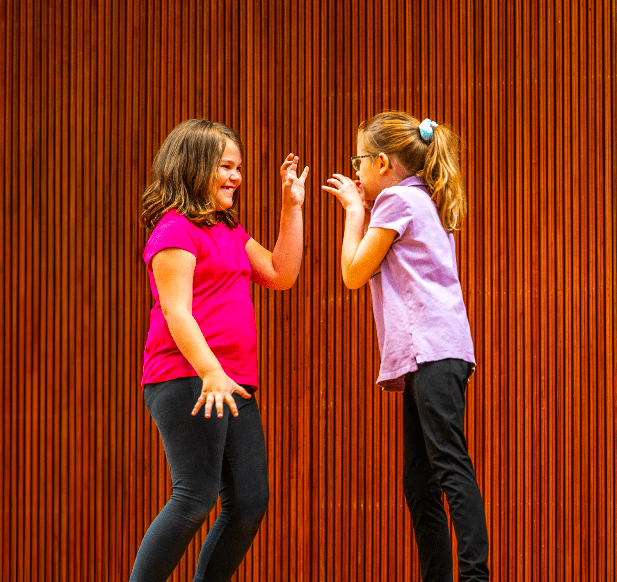
I remember the day I was working on a choreography and realized that I was allowed to appreciate my body. It was a profoundly personal, affirming moment. This work challenges us and changes us. For me, that’s the joy—joy I discovered by reveling in the spirit of play long enough to get to the other side. Jaques-Dalcroze created a means for us to fully know ourselves as students, teachers, and artists. He gave us a gift.
In his book Free Play, Stephen Nachmanovitch sums up play, joy, and self-knowledge:
Like other manifestations of the Muse, the child is the voice of our own inner knowing. The first language of the knowing is play. In this light, psychiatrist Donald Winnicott came to clarify the aim of psychological healing as “bringing the patient from a state of not being able to play to a state of being able to play…It is in playing and only in playing that the individual child or adult is able to be creative and to use the whole personality, and it is only in being creative that the individual discovers the self.”
Free Play, p. 51
Nachmanovitch reminds us that “the most potent muse of all is our own inner child. The poet, musician, artist continues throughout life to contact this child, the self who still knows how to play” (p. 47).
May the spirit of play be with you!
Works Cited
- Aten, Jaime D. 2020. “What Is Joy and What Does It Say About Us?” Psychology Today. https://www.psychologytoday.com/us/blog/hope-resilience/202007/what-is-joy-and-what-does-it-say-about-us.
- Jaques-Dalcroze, Émile. 1930. Eurhythmics, Art, and Education. A.S. Barnes and Co.
- Jaques-Dalcroze, Émile. 1980. Rhythm, Music and Education. Aylesbury, The Dalcroze Society.
- Kim I. Mills, host, Speaking of Psychology, podcast transcript, episode 266, “Why We Learn Best Through Play,” American Psychological Association, December, 2023, https://www.apa.org/news/podcasts/speaking-of-psychology/play.
- Nachmanovitch, Stephen. 1990. Free Play: The Power of Improvisation in Life and the Arts. Jeremy Tarcher, Inc.
- Psychology Today. “Play.” https://www.psychologytoday.com/us/basics/play. Accessed June, 2024
- Rosenstrauch, Henrietta. 1973. Essays on Rhythm, Music, Movement. Pittsburgh, Volkwein Bros., Inc.
- Wilson, Bruce. 2023. “Experiencing Your Multiple Domains of Joy.” Psychology Today. https://www.psychologytoday.com/us/blog/explorations-in-positive-psychology/202310/experiencing-your-multiple-domains-of-joy.
This article was originally published in the Fall 2024 issue of Dalcroze Connections, Vol. 9 No. 1.